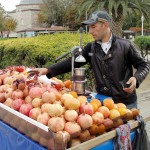A Tale’s Sense of Place.
 The Art of Being There in Fiction.
The Art of Being There in Fiction.
I have found that the best way to bring a sense of place to readers is through research. The characters may be fictitious, but the reality of location makes the story more interesting and believable.
Many people enjoy reading novels that are set in places they visit. I am one of them. In my youth, I read about the ancient Minoan civilization on the island of Crete. The story stoked my desire to see the place for myself. When I visited the ancient ruins, it was like enjoying an impressionist painting. The structural foundation was there, and my knowledge completed the picture.
Much of the action in the first volume of my Benny Goldfarb, Private “I” series takes place in Colombia. I researched the locations, the history, the culture, and the food. The next year, after the book’s publication, my wife and I had the good fortune to visit Cartagena. We hired a driver to take us on a tour of the city, stopping at places described in the book. He heard me informing my wife, in detail, about the sites. “You have been here before?” he asked. I explained that I was an author. My mind had been here before. This was the first time for my body.
A story can be more than a story. It can morph into a three-dimensional experience that comes alive when you visit the setting—but only if the writer’s research is woven into the tale’s fabric.

